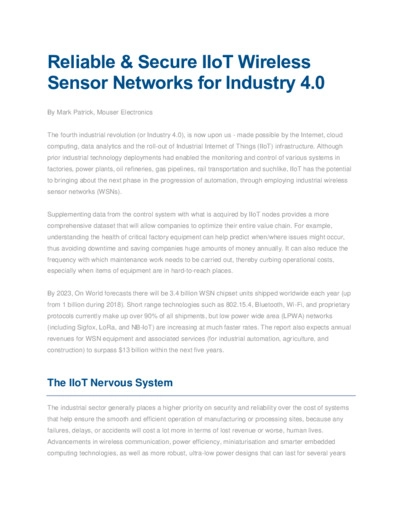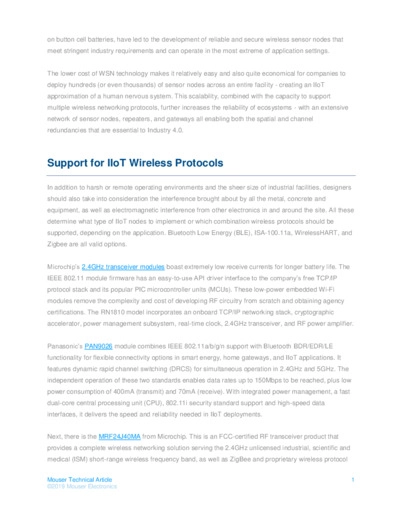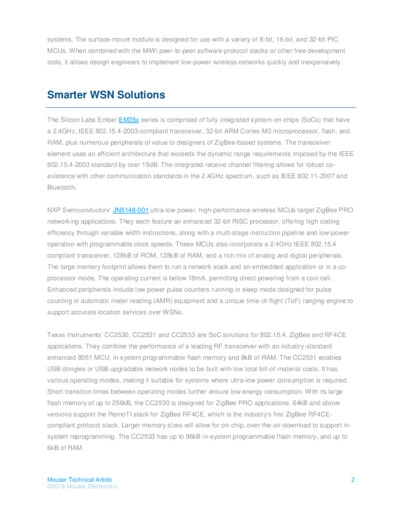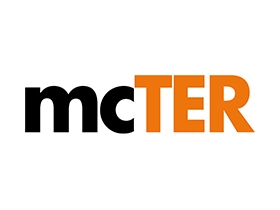Reliable & Secure IIoT Wireless Sensor Networks for Industry 4.0
Mark Patrick - Mouser Electronics
Although prior industrial technology deployments had enabled the monitoring and control of various systems in factories, power plants, oil refineries, gas pipelines, rail transportation and suchlike, IIoT has the potential to bringing about the next phase in the progression of automation, through employing industrial wireless sensor networks.
The fourth industrial revolution (or Industry 4.0), is now upon us - made possible by the Internet, cloud computing, data analytics and the roll-out of Industrial Internet of Things (IIoT) infrastructure. Although prior industrial technology deployments had enabled the monitoring and control of various systems in factories, power plants, oil refineries, gas pipelines, rail transportation and suchlike, IIoT has the potential to bringing about the next phase in the progression of automation, through employing industrial wireless sensor networks (WSNs).
Supplementing data from the control system with what is acquired by IIoT nodes provides a more comprehensive dataset that will allow companies to optimize their entire value chain. For example, understanding the health of critical factory equipment can help predict when/where issues might occur, thus avoiding downtime and saving companies huge amounts of money annually. It can also reduce the frequency with which maintenance work needs to be carried out, thereby curbing operational costs, especially when items of equipment are in hard-to-reach places.
By 2023, On World forecasts there will be 3.4 billion WSN chipset units shipped worldwide each year (up from 1 billion during 2018). Short range technologies such as 802.15.4, Bluetooth, Wi-Fi, and proprietary protocols currently make up over 90% of all shipments, but low power wide area (LPWA) networks (including Sigfox, LoRa, and NB-IoT) are increasing at much faster rates. The report also expects annual revenues for WSN equipment and associated services (for industrial automation, agriculture, and construction) to surpass $13 billion within the next five years.
The IIoT Nervous System
The industrial sector generally places a higher priority on security and reliability over the cost of systems that help ensure the smooth and efficient operation of manufacturing or processing sites, because any failures, delays, or accidents will cost a lot more in terms of lost revenue or worse, human lives. Advancements in wireless communication, power efficiency, miniaturisation and smarter embedded computing technologies, as well as more robust, ultra-low power designs that can last for several years on button cell batteries, have led to the development of reliable and secure wireless sensor nodes that meet stringent industry requirements and can operate in the most extreme of application settings.
The lower cost of WSN technology makes it relatively easy and also quite economical for companies to deploy hundreds (or even thousands) of sensor nodes across an entire facility - creating an IIoT approximation of a human nervous system. This scalability, combined with the capacity to support multiple wireless networking protocols, further increases the reliability of ecosystems - with an extensive network of sensor nodes, repeaters, and gateways all enabling both the spatial and channel redundancies that are essential to Industry 4.0.
Support for IIoT Wireless Protocols
In addition to harsh or remote operating environments and the sheer size of industrial facilities, designers should also take into consideration the interference brought about by all the metal, concrete and equipment, as well as electromagnetic interference from other electronics in and around the site. All these determine what type of IIoT nodes to implement or which combination wireless protocols should be supported, depending on the application. Bluetooth Low Energy (BLE), ISA-100.11a, WirelessHART, and Zigbee are all valid options.
Microchip's 2.4GHz transceiver modules boast extremely low receive currents for longer battery life. The IEEE 802.11 module firmware has an easy-to-use API driver interface to the company's free TCP/IP protocol stack and its popular PIC microcontroller units (MCUs). These low-power embedded Wi-Fi modules remove the complexity and cost of developing RF circuitry from scratch and obtaining agency certifications. The RN1810 model incorporates an onboard TCP/IP networking stack, cryptographic accelerator, power management subsystem, real-time clock, 2.4GHz transceiver, and RF power amplifier.
Panasonic's PAN9026 module combines IEEE 802.11a/b/g/n support with Bluetooth BDR/EDR/LE functionality for flexible connectivity options in smart energy, home gateways, and IIoT applications. It features dynamic rapid channel switching (DRCS) for simultaneous operation in 2.4GHz and 5GHz. The independent operation of these two standards enables data rates up to 150Mbps to be reached, plus low power consumption of 400mA (transmit) and 70mA (receive). With integrated power management, a fast dual-core central processing unit (CPU), 802.11i security standard support and high-speed data interfaces, it delivers the speed and reliability needed in IIoT deployments.
Next, there is the MRF24J40MA from Microchip. This is an FCC-certified RF transceiver product that provides a complete wireless networking solution serving the 2.4GHz unlicensed industrial, scientific and medical (ISM) short-range wireless frequency band, as well as ZigBee and proprietary wireless protocol systems. The surface-mount module is designed for use with a variety of 8-bit, 16-bit, and 32-bit PIC MCUs. When combined with the MiWi peer-to-peer software-protocol stacks or other free development tools, it allows design engineers to implement low-power wireless networks quickly and inexpensively.
Smarter WSN Solutions
The Silicon Labs Ember EM35x series is comprised of fully integrated system-on-chips (SoCs) that have a 2.4GHz, IEEE 802.15.4-2003-compliant transceiver, 32-bit ARM Cortex-M3 microprocessor, flash, and RAM, plus numerous peripherals of value to designers of ZigBee-based systems. The transceiver element uses an efficient architecture that exceeds the dynamic range requirements imposed by the IEEE 802.15.4-2003 standard by over 15dB. The integrated receive channel filtering allows for robust co-existence with other communication standards in the 2.4GHz spectrum, such as IEEE 802.11-2007 and Bluetooth.
NXP Semiconductors' JN5148-001 ultra-low power, high-performance wireless MCUs target ZigBee PRO networking applications. They each feature an enhanced 32-bit RISC processor, offering high coding efficiency through variable width instructions, along with a multi-stage instruction pipeline and low-power operation with programmable clock speeds. These MCUs also incorporate a 2.4GHz IEEE 802.15.4 compliant transceiver, 128kB of ROM, 128kB of RAM, and a rich mix of analog and digital peripherals. The large memory footprint allows them to run a network stack and an embedded application or in a co-processor mode. The operating current is below 18mA, permitting direct powering from a coin cell. Enhanced peripherals include low power pulse counters running in sleep mode designed for pulse counting in automatic meter reading (AMR) equipment and a unique time-of-flight (ToF) ranging engine to support accurate location services over WSNs.
Texas Instruments' CC2530, CC2531 and CC2533 are SoC solutions for 802.15.4, ZigBee and RF4CE applications. They combine the performance of a leading RF transceiver with an industry-standard enhanced 8051 MCU, in-system programmable flash memory and 8kB of RAM. The CC2531 enables USB dongles or USB upgradable network nodes to be built with low total bill-of-material costs. It has various operating modes, making it suitable for systems where ultra-low power consumption is required. Short transition times between operating modes further ensure low energy consumption. With its large flash memory of up to 256kB, the CC2530 is designed for ZigBee PRO applications. 64kB and above versions support the RemoTI stack for ZigBee RF4CE, which is the industry's first ZigBee RF4CE-compliant protocol stack. Larger memory sizes will allow for on-chip, over-the-air-download to support in-system reprogramming. The CC2533 has up to 96kB in-system programmable flash memory, and up to 6kB of RAM.
Analog Devices' SmartMesh IP wireless solutions (from the Dust Networks product group) consist of embedded chips and pre-certified PCB modules. The modules come complete with fully developed, field-proven, intelligent wireless mesh networking software. SmartMesh WSNs are capable of delivering strong data reliability (>99.999%) over ultra-low power, secure wireless communications. This enables sensors to be placed in uncompromising IIoT environments. At the heart of the SmartMesh motes and their related network manager boards is the Eterna IEEE 802.15.4e SoC, which features the company's highly integrated, low-power 2.4GHz radio design. It also features an ARM Cortex-M3 32-bit microprocessor running SmartMesh networking software.
Figure 1: The Panasonic PAN9026 module.
Figure 2: SmartMesh IP Technology from Analog Devices.
Figure 3: Motes and Network Manager Boards Supporting SmartMesh IP Technology.
The WSN hardware needed to support the widespread proliferation of Industry 4.0 technology is getting there. ICs and modules can now be found on the market that attain the performance levels required, while also coping with power budget constraints, challenging operating conditions and an array of different security threats. Consequently, in the coming years, the many benefits that can be derived from increased automation will begin to be realized globally.
Supplementing data from the control system with what is acquired by IIoT nodes provides a more comprehensive dataset that will allow companies to optimize their entire value chain. For example, understanding the health of critical factory equipment can help predict when/where issues might occur, thus avoiding downtime and saving companies huge amounts of money annually. It can also reduce the frequency with which maintenance work needs to be carried out, thereby curbing operational costs, especially when items of equipment are in hard-to-reach places.
By 2023, On World forecasts there will be 3.4 billion WSN chipset units shipped worldwide each year (up from 1 billion during 2018). Short range technologies such as 802.15.4, Bluetooth, Wi-Fi, and proprietary protocols currently make up over 90% of all shipments, but low power wide area (LPWA) networks (including Sigfox, LoRa, and NB-IoT) are increasing at much faster rates. The report also expects annual revenues for WSN equipment and associated services (for industrial automation, agriculture, and construction) to surpass $13 billion within the next five years.
The IIoT Nervous System
The industrial sector generally places a higher priority on security and reliability over the cost of systems that help ensure the smooth and efficient operation of manufacturing or processing sites, because any failures, delays, or accidents will cost a lot more in terms of lost revenue or worse, human lives. Advancements in wireless communication, power efficiency, miniaturisation and smarter embedded computing technologies, as well as more robust, ultra-low power designs that can last for several years on button cell batteries, have led to the development of reliable and secure wireless sensor nodes that meet stringent industry requirements and can operate in the most extreme of application settings.
The lower cost of WSN technology makes it relatively easy and also quite economical for companies to deploy hundreds (or even thousands) of sensor nodes across an entire facility - creating an IIoT approximation of a human nervous system. This scalability, combined with the capacity to support multiple wireless networking protocols, further increases the reliability of ecosystems - with an extensive network of sensor nodes, repeaters, and gateways all enabling both the spatial and channel redundancies that are essential to Industry 4.0.
Support for IIoT Wireless Protocols
In addition to harsh or remote operating environments and the sheer size of industrial facilities, designers should also take into consideration the interference brought about by all the metal, concrete and equipment, as well as electromagnetic interference from other electronics in and around the site. All these determine what type of IIoT nodes to implement or which combination wireless protocols should be supported, depending on the application. Bluetooth Low Energy (BLE), ISA-100.11a, WirelessHART, and Zigbee are all valid options.
Microchip's 2.4GHz transceiver modules boast extremely low receive currents for longer battery life. The IEEE 802.11 module firmware has an easy-to-use API driver interface to the company's free TCP/IP protocol stack and its popular PIC microcontroller units (MCUs). These low-power embedded Wi-Fi modules remove the complexity and cost of developing RF circuitry from scratch and obtaining agency certifications. The RN1810 model incorporates an onboard TCP/IP networking stack, cryptographic accelerator, power management subsystem, real-time clock, 2.4GHz transceiver, and RF power amplifier.
Panasonic's PAN9026 module combines IEEE 802.11a/b/g/n support with Bluetooth BDR/EDR/LE functionality for flexible connectivity options in smart energy, home gateways, and IIoT applications. It features dynamic rapid channel switching (DRCS) for simultaneous operation in 2.4GHz and 5GHz. The independent operation of these two standards enables data rates up to 150Mbps to be reached, plus low power consumption of 400mA (transmit) and 70mA (receive). With integrated power management, a fast dual-core central processing unit (CPU), 802.11i security standard support and high-speed data interfaces, it delivers the speed and reliability needed in IIoT deployments.
Next, there is the MRF24J40MA from Microchip. This is an FCC-certified RF transceiver product that provides a complete wireless networking solution serving the 2.4GHz unlicensed industrial, scientific and medical (ISM) short-range wireless frequency band, as well as ZigBee and proprietary wireless protocol systems. The surface-mount module is designed for use with a variety of 8-bit, 16-bit, and 32-bit PIC MCUs. When combined with the MiWi peer-to-peer software-protocol stacks or other free development tools, it allows design engineers to implement low-power wireless networks quickly and inexpensively.
Smarter WSN Solutions
The Silicon Labs Ember EM35x series is comprised of fully integrated system-on-chips (SoCs) that have a 2.4GHz, IEEE 802.15.4-2003-compliant transceiver, 32-bit ARM Cortex-M3 microprocessor, flash, and RAM, plus numerous peripherals of value to designers of ZigBee-based systems. The transceiver element uses an efficient architecture that exceeds the dynamic range requirements imposed by the IEEE 802.15.4-2003 standard by over 15dB. The integrated receive channel filtering allows for robust co-existence with other communication standards in the 2.4GHz spectrum, such as IEEE 802.11-2007 and Bluetooth.
NXP Semiconductors' JN5148-001 ultra-low power, high-performance wireless MCUs target ZigBee PRO networking applications. They each feature an enhanced 32-bit RISC processor, offering high coding efficiency through variable width instructions, along with a multi-stage instruction pipeline and low-power operation with programmable clock speeds. These MCUs also incorporate a 2.4GHz IEEE 802.15.4 compliant transceiver, 128kB of ROM, 128kB of RAM, and a rich mix of analog and digital peripherals. The large memory footprint allows them to run a network stack and an embedded application or in a co-processor mode. The operating current is below 18mA, permitting direct powering from a coin cell. Enhanced peripherals include low power pulse counters running in sleep mode designed for pulse counting in automatic meter reading (AMR) equipment and a unique time-of-flight (ToF) ranging engine to support accurate location services over WSNs.
Texas Instruments' CC2530, CC2531 and CC2533 are SoC solutions for 802.15.4, ZigBee and RF4CE applications. They combine the performance of a leading RF transceiver with an industry-standard enhanced 8051 MCU, in-system programmable flash memory and 8kB of RAM. The CC2531 enables USB dongles or USB upgradable network nodes to be built with low total bill-of-material costs. It has various operating modes, making it suitable for systems where ultra-low power consumption is required. Short transition times between operating modes further ensure low energy consumption. With its large flash memory of up to 256kB, the CC2530 is designed for ZigBee PRO applications. 64kB and above versions support the RemoTI stack for ZigBee RF4CE, which is the industry's first ZigBee RF4CE-compliant protocol stack. Larger memory sizes will allow for on-chip, over-the-air-download to support in-system reprogramming. The CC2533 has up to 96kB in-system programmable flash memory, and up to 6kB of RAM.
Analog Devices' SmartMesh IP wireless solutions (from the Dust Networks product group) consist of embedded chips and pre-certified PCB modules. The modules come complete with fully developed, field-proven, intelligent wireless mesh networking software. SmartMesh WSNs are capable of delivering strong data reliability (>99.999%) over ultra-low power, secure wireless communications. This enables sensors to be placed in uncompromising IIoT environments. At the heart of the SmartMesh motes and their related network manager boards is the Eterna IEEE 802.15.4e SoC, which features the company's highly integrated, low-power 2.4GHz radio design. It also features an ARM Cortex-M3 32-bit microprocessor running SmartMesh networking software.
Figure 1: The Panasonic PAN9026 module.
Figure 2: SmartMesh IP Technology from Analog Devices.
Figure 3: Motes and Network Manager Boards Supporting SmartMesh IP Technology.
The WSN hardware needed to support the widespread proliferation of Industry 4.0 technology is getting there. ICs and modules can now be found on the market that attain the performance levels required, while also coping with power budget constraints, challenging operating conditions and an array of different security threats. Consequently, in the coming years, the many benefits that can be derived from increased automation will begin to be realized globally.
Settori: Automazione industriale, Industria 4.0, Informatica, IoT, Reti di comunicazione, Sensoristica, Software industriale, Telecomunicazioni
- Endress+Hauser Italia
- Aveva Software Italia
- Alberto Servida
- Endress+Hauser Italia
 English
English
























